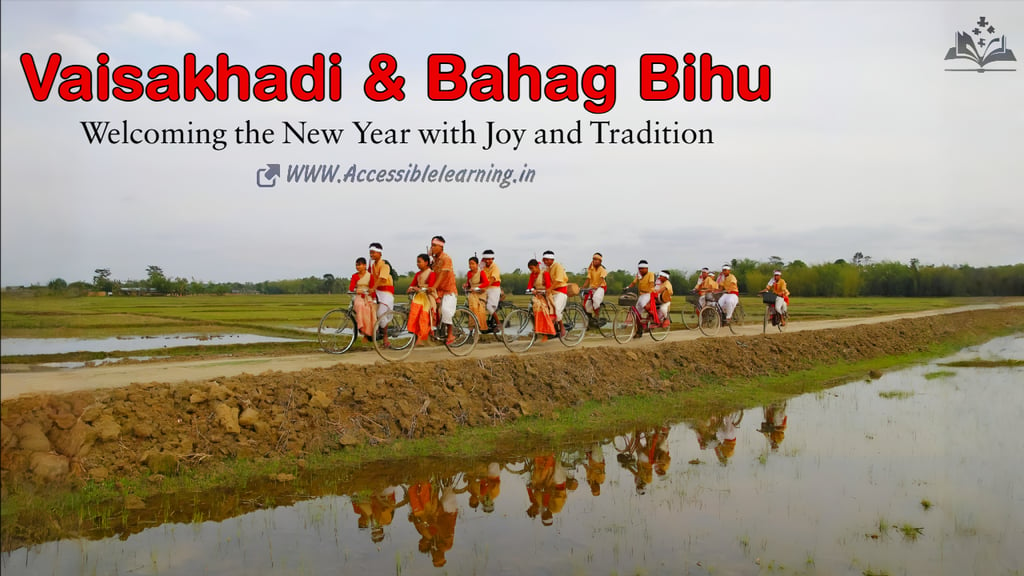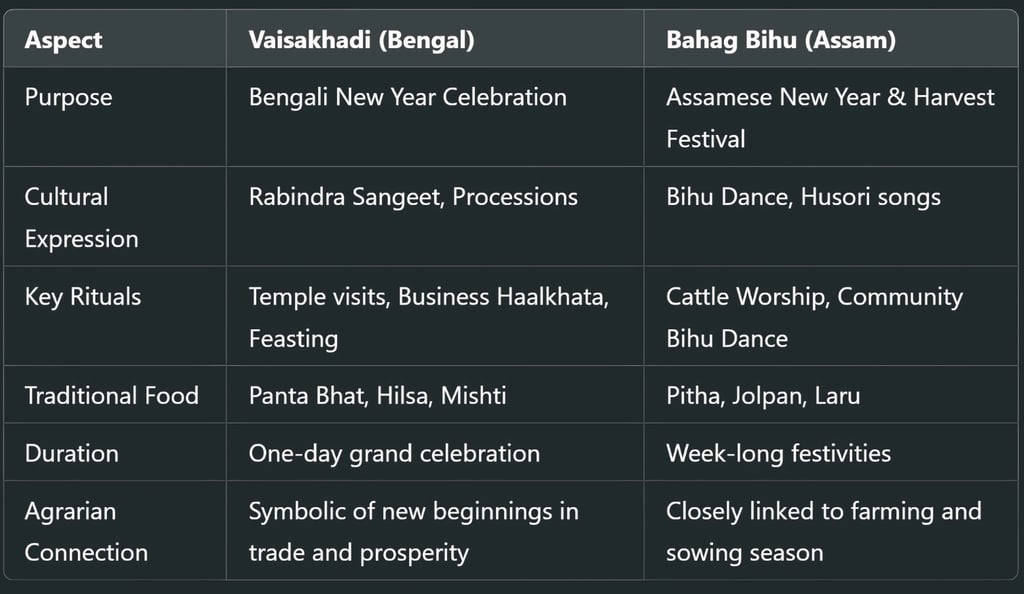
Vaisakhadi & Bahag Bihu: Welcoming the New Year with Joy and Tradition
Discover the vibrant celebrations of Vaisakhadi (Pohela Boishakh) in Bengal and Bahag Bihu in Assam—two festivals marking the new year, harvest season, and cultural richness of these regions. Learn about their history, rituals, food, music, and agrarian significance, showcasing India's diverse traditions.
CULTURE/TRADITIONEVENT/SPECIALEDUCATION/KNOWLEDGEINDIA/BHARATCELEBRATION/FESTIVALS
Keshav Jha
4/3/20253 min read


India, a land of diverse cultures and traditions, welcomes the new year in various ways across different regions. Among these celebrations, Vaisakhadi in Bengal and Bahag Bihu in Assam stand out as vibrant and joyous festivals marking the arrival of spring, the new year, and the harvest season. Rooted deeply in agrarian traditions, these festivals embody the spirit of renewal, gratitude, and cultural unity. Let's explore the significance, rituals, and festive fervor surrounding these magnificent celebrations.
Vaisakhadi (Bengal)—The Bengali New Year
Vaisakhadi, also known as Pohela Boishakh, marks the first day of the Bengali calendar (Bengali Era or Bangabda). This day signifies a fresh start for Bengalis worldwide, celebrated with enthusiasm across West Bengal, Bangladesh, and Bengali communities worldwide.
Rituals and Celebrations
Mangal Shobhajatra: A grand cultural procession, declared as an Intangible Cultural Heritage by UNESCO, showcases folk performances, colorful masks, and large artistic structures symbolizing prosperity.
Greet with ‘Shubho Noboborsho’: People exchange warm wishes, saying ‘Shubho Noboborsho’ (Happy New Year).
Haalkhata: Shopkeepers and businessmen initiate new accounting books (Haalkhata), inviting customers for sweets and blessings.
Traditional Feasts: Special dishes like Panta Bhat (fermented rice), Ilish Maach (Hilsa fish), and Mishti (sweets like Rosogolla and Sandesh) are prepared.
Cultural Programs: Rabindra Sangeet (songs of Rabindranath Tagore), Baul music, and traditional dance performances highlight the day.
Street Fairs and Art Exhibitions: Many cities organize fairs with handicrafts, local art, and food stalls, promoting Bengali heritage.
Religious Aspects
Devotees visit temples like Dakshineswar and Kalighat in Kolkata, seeking blessings for a prosperous year.
Prayers and rituals are conducted to honor deities and ensure a good agricultural yield.
Chaitra Sankranti: The last day of the previous year is observed with fasting and special pujas, symbolizing letting go of past hardships and embracing a new start.


Bahag Bihu (Assam)—The Assamese New Year and Harvest Festival
Bahag Bihu, the most celebrated among the three Bihus of Assam (Rongali, Kati, and Magh), signifies the Assamese New Year and the onset of the sowing season. This week-long festival, also called Rongali Bihu, is deeply rooted in agrarian culture, symbolizing joy, fertility, and gratitude to nature.
Phases and Festivities
Goru Bihu (Cow Bihu)—April 13
Cattle are bathed with turmeric, decorated, and fed special food as a gesture of gratitude.
Farmers sing traditional Bihu songs while cleaning and preparing the fields for cultivation.
Manuh Bihu (Human Bihu)—April 14
People wear new clothes and seek blessings from elders.
Traditional Assamese dishes like pitha (rice cakes), jolpan (sticky rice with curd), and laru (sweet coconut balls) are prepared.
Cultural performances, especially Bihu dance and Bihu geet (songs), take center stage.
Families come together to perform rituals for deceased ancestors, seeking their blessings for a prosperous year ahead.
Husori and Mukoli Bihu—April 15 Onwards
Groups of young men and women visit homes, singing and dancing, receiving gifts and blessings in return.
Open-air performances, locally known as Mukoli Bihu, add to the festive spirit.
Villages and urban areas host Bihu fairs, where traditional sports like buffalo fights, egg fights, and tug-of-war take place.
Community and Cultural Essence
Bihu Dance and Music: Performed with traditional instruments like Dhol (drum), Pepa (buffalo horn pipe), Taal (cymbals), and Gogona (bamboo instrument).
Bihu Fairs and Competitions: Events such as traditional wrestling (Mukoli Bihu competitions) and cultural exhibitions attract large crowds.
Xaat Bihu (Seven Days of Bihu): Each day of the week has specific rituals and customs, making it an extended celebration.
Meji and Bhelaghar: Huge structures made of bamboo and hay are burned in some communities, symbolizing the destruction of evil forces and welcoming warmth and prosperity.


Both Vaisakhadi (Pohela Boishakh) and Bahag Bihu reflect the deep-rooted cultural and agrarian traditions of Bengal and Assam, respectively. While Pohela Boishakh emphasizes renewal, prosperity, and artistic expressions, Bahag Bihu is a vibrant tribute to nature, agriculture, and Assamese traditions. Despite regional differences, both festivals symbolize new beginnings, joy, and cultural pride, making them an integral part of India’s rich festive tapestry.
As we celebrate these occasions, we not only cherish our past but also embrace the promise of a new and prosperous year ahead. Shubho Noboborsho! Happy Rongali Bihu!
Subscribe To Our Newsletter
All © Copyright reserved by Accessible-Learning Hub
| Terms & Conditions
Knowledge is power. Learn with Us. 📚


